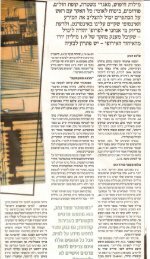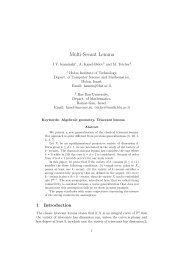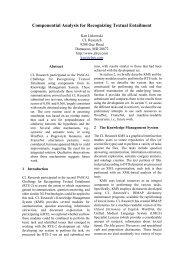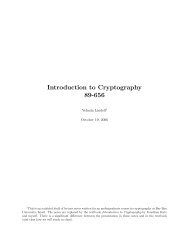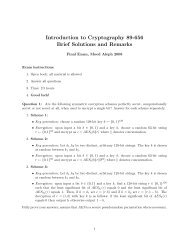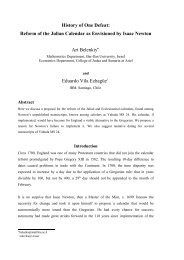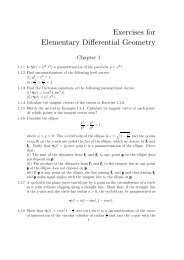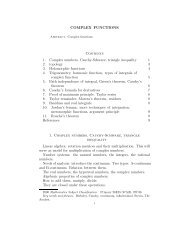Resolving Uncertainty: A Unified Overview of Rabbinic Methods
Resolving Uncertainty: A Unified Overview of Rabbinic Methods
Resolving Uncertainty: A Unified Overview of Rabbinic Methods
You also want an ePaper? Increase the reach of your titles
YUMPU automatically turns print PDFs into web optimized ePapers that Google loves.
elations prior to marriage would be forbidden to her husband if she had done so (A)<br />
subsequent to betrothal and (B) consensually (Ketubot 9a). Of the four possibilities<br />
(subsequent/consensual, subsequent/not-consensual, prior/consensual, prior/notconsensual),<br />
only one renders her forbidden. Consequently, if we are in doubt as to<br />
which <strong>of</strong> these four possibilities is indeed the case, we can follow the majority and<br />
she would not be forbidden to her husband.<br />
If indeed sfek sfeka is a type <strong>of</strong> rov, in its mechanics as well as its effect, it is certainly<br />
not RDLK since many examples <strong>of</strong> sfek sfeka, such as the one above, are not amenable<br />
to explanation in terms <strong>of</strong> RDLK 20 . Moreover, there are differences between sfek sfeka<br />
and RDLK even in terms <strong>of</strong> effect. We have already seen that R. Meir's principle <strong>of</strong><br />
chaishinan lemiuta applies only to RDLK and not to RDIK. But in Nidda 59b we find<br />
that (according to R. Yohanan) R. Meir invokes a sfek sfeka against chazakah d'me-ikara<br />
and appears unconcerned with the principle <strong>of</strong> chaishinan lemiuta. This is consistent<br />
with sfek sfeka as an extension <strong>of</strong> RDIK but not as RDLK 21 .<br />
20<br />
For example, the question <strong>of</strong> whether a particular woman is more likely to have had relations<br />
subsequent to or prior to her betrothal would appear to depend on the circumstances <strong>of</strong> the case in<br />
question; there is no evidence <strong>of</strong> any general statistical rule that the Rabbis applied to all such cases. For<br />
more convincing examples <strong>of</strong> the inapplicability <strong>of</strong> RDLK, see M. Taharot 6:4 and Nidda 33b. It is<br />
important to note that there are cases <strong>of</strong> sfek sfeka and pseudo-sfek sfeka which happen to also be RDLK.<br />
For example, in Hullin 77b, Rashi s.v. vechol hayoldot (perhaps based on JT Yebamot 16:1) formulates the<br />
gemara's claim that most births are not both living and males in terms <strong>of</strong> sfek sfeka even though<br />
stillbirths are clearly a minority. The reason that this works is that it happens to also be a RDLK (See<br />
Shev Shmaatse 1:18). Similarly, Rambam Hil. Para Aduma 9:16 employs the terminology <strong>of</strong> sfek sfeka to<br />
explain the gemara's claim (Hullin 9b) that mei chatat that are found uncovered can be assumed not to<br />
have been handled by an agent who was both human and tamei. This would contradict the law that sfek<br />
sfeka b'reshut hayachid tamei except that it also happens to be a RDLK. See also Bava Kama 11a , Tosafot<br />
s.v. d'eino.<br />
21<br />
Still, it must be noted that a majority <strong>of</strong> possibilities as in sfek sfeka is not always treated in exactly the<br />
same way as a majority <strong>of</strong> concrete objects as in the usual case <strong>of</strong> RDIK. In Tosefta Taharot 6:2 (as<br />
explained in Ketubot 15a), we find that in a case <strong>of</strong> safek tumah involving parish (the word used in the<br />
Tosefta is nimtsa), we follow the majority even for leniency; only in a case <strong>of</strong> kavua, do we follow the rule<br />
that safek tumah b'reshut hayachid tamei. Nevertheless, in M. Taharot 6:4 we find that sfek sfeka regarding<br />
tumah be-reshut hayachid is an inadequate basis for leniency. On the face <strong>of</strong> it, this would suggest that<br />
sfek sfeka is treated differently than RDIK. See Resp. Achiezer [Yoreh Deah] Resp. 2, Par. 13.<br />
It would appear more appropriate , however, to ascribe this anomaly to the generally exceptional nature<br />
<strong>of</strong> the principle safek tumah b'reshut hayachid tamei. As is evident from the Tosefta, safek tumah refers<br />
specifically to cases <strong>of</strong> kavua, which, as we have seen, is an atypical use <strong>of</strong> the term safek. Thus, it would<br />
appear that the sfek sfeka cases in the Mishnah are regarded as more similar to the Tosefta's kavua case<br />
than to the RDIK case. In fact, Rav Soloveichik argues that the rule that safek tumah b'reshut hayachid<br />
tamei employed in the Mishnah applies only when the presence <strong>of</strong> tumah is certain so that the only<br />
uncertainty involves whether it was metamei other things. Thus all cases <strong>of</strong> safek tumah for which the rule<br />
is relevant may full under some broader definition <strong>of</strong> kavua (alluded to in footnote 16 above with regard<br />
to asham taluy). Consequently, the rule is inapplicable in the nimtsa case <strong>of</strong> the Tosefta in which RDIK is<br />
applied to a single object which might not be tamei at all. (It is difficult, however, to reconcile this<br />
restriction to the rule with the language <strong>of</strong> the Mishnah where the rule is applied: "safek haytah sham,<br />
safek lo haytah sham".) See Shiurei HaRav Aharon Lichtenstein on Taharot, pp. 167-171. (For another<br />
example <strong>of</strong> the atypicality <strong>of</strong> the rule safek tumah b'reshut hayachid tamei, see footnote 18 above.)



